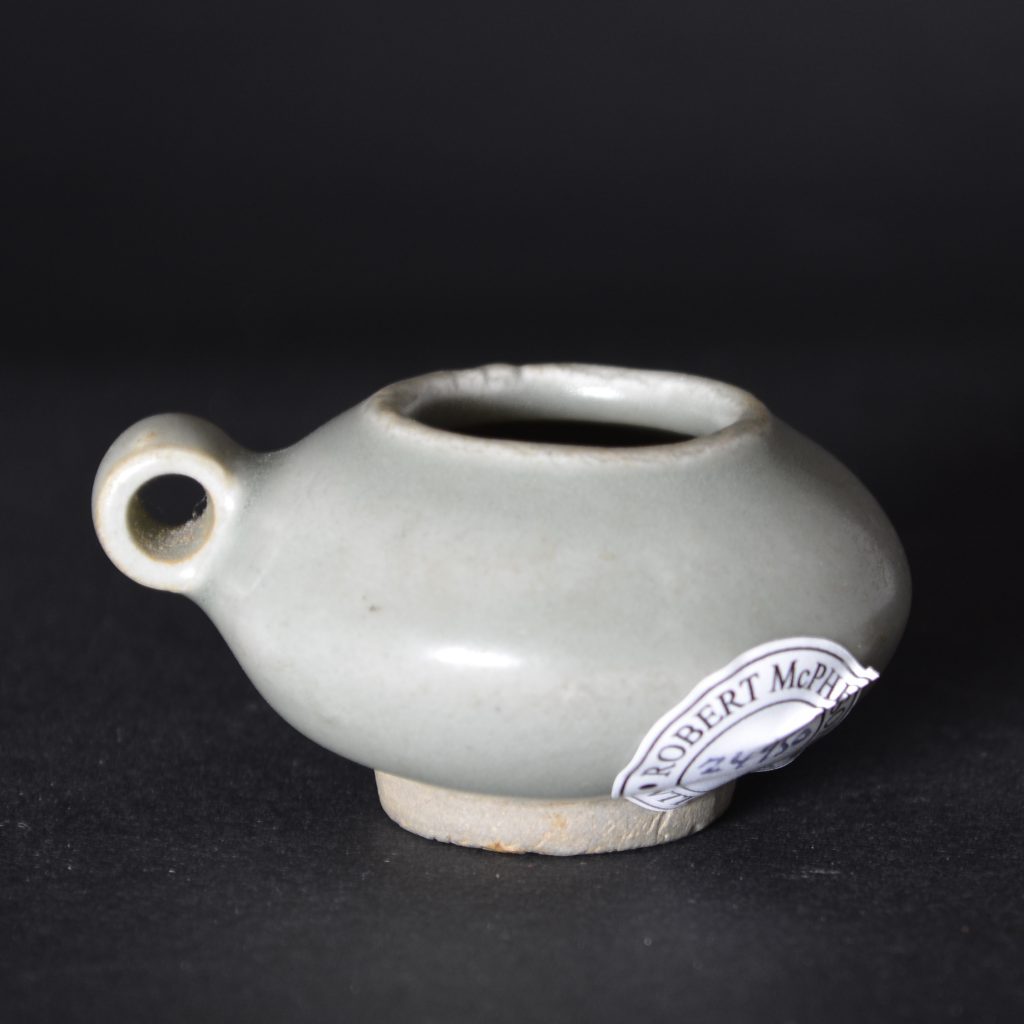
Song or Yuan Celadon Bird Feeder 13th to Early 14th Century
A small Song or Yuan Celadon Ware bird feeder, probably Longquan kilns, 13th or early 14th century. Of compressed circular form and unglazed base this Chinese Celadon bird feeder has a loop on the side to attach it to the interior of the bird cage. The colour is less grey and more green than appears in the photographs.
SOLD
- Condition
- In excellent condition, minor feint scratches.
- Size
- Length: 4.8cm (2 inches)
- Provenance
- A Private London Collection of Early Chinese Ceramics. Lable to the base, number 304.
- Stock number
- 24950
- References
- For a very similar Chinese celadon bird feeder, dated to the Yuan dynasty from the Eric E. Geiling Collection, Exhibited at The Cologne Museum of Oriental Art, see : Chinesische Keramik Auf Den Philippinen (Die Sammlung Eric E. Geiling, Bearbeitet Von Ulrich Wiesner, Museum Fur Ostasiatische Kunst) page 90, plate 52.
Information
Celadon Ware :
Celadon is a term used to describe several types of Chinese stoneware and porcelain, as well a ceramics from other countries, notably from Korea and Japan. The term is a imprecise one, applying to various types of green glazed ceramics, but not all ceramics with green glazes, there are several wares that have a green glaze that are not refereed to as celadon. For example Green Jun and Ge Ware. For this reason there has been a move to try to clarify the situation by using the term `Green Ware`. But for now Celadon is a more familiar and therefore useful term. The origins of the term Celadon are not clear, one theory is that the term first appeared in France in the 17th century and that it is named after the shepherd Celadon in Honoré d`Urfé`s French pastoral romance, L`Astrée (1627), who wore pale green ribbons. (D`Urfe, in turn, borrowed his character from Ovid`s Metamorphoses.) Another theory is that the term is a corruption of the name of Saladin, the Ayyubid Sultan, who in 1171 sent forty pieces of the ceramic to Nur ad-Din, Sultan of Syria. Yet a third theory is that the word derives from the Sanskrit sila and dhara, which mean “stone” and “green” respectively. Celadon ware originated in Zhejiang Province in the Eastern Han Dynasty, however green monochrome glazes can be found on stoneware much before that date. Zhejiang is were the famous Longquan Celadons were made but Celadon wares were also produced at Jiangsu, Hubei, Hunan and Jiangxi. The production of Celadon Ware required a reducing atmosphere of around 1300 degrees C., the colouring agent was a mixture of iron oxide and titanium. The glaze was applied very thickly, and was full of tiny bubbles which defuse the light giving the appearance of richness and softness.
Yuan Dynasty :
Temüjin, later to be more prominently known as Genghis Khan, was officially the first in the line of Yuan Dynasty emperors. He was the son of Yesügei, the tribal chief of the Kiyad — a tribe in fragmented Mongolia under nominal control of the Jin Dynasty at the time. His father was killed in his early life by a rival tribe, the heir. This led to bitterness on the part of Senggum, Wang`s former heir, who planned to assassinate Temüjin. Temüjin learned of Senggum`s intentions however, and a large civil war broke out among the Mongols. Eventually Temüjin defeated Senggum and succeeded to the title of Wang Khan. Temüjin created a written code of laws for the Mongols called Yassa, and he demanded it to be followed very strictly. Temüjin followed with attacks on other neighboring tribes, which further increased his power. By combining diplomacy, organization, military ability, and brutality, Temüjin finally managed to unite the tribes into the single nation, a monumental feat for the Mongols, who had a long history of internecine dispute. In 1206 Temüjin successfully united the formerly fragmented tribes of what is now Mongolia. At a Khurultai (a council of Mongol chiefs), he was named the “Genghis Khan”, or the “Universal Ruler”. The birth of Mongolia marked the start of what would become the largest continuous empire in history, ruling large parts of Asia, the Middle East and parts of Europe, over the following two centuries. While his empire extended in all directions, Genghis Khan’s main interest was always with the rest of China, specifically Western Xia, Jin Dynasty and southern Song Dynasty.


